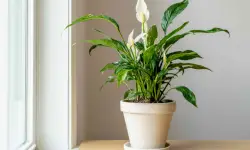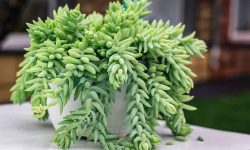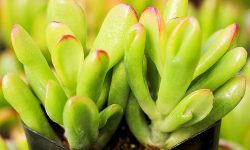African violets (Saintpaulia spp.) are popular indoor plants cherished for their striking flowers and velvety leaves. But when their leaves start to droop, it can be disconcerting for plant lovers. Identifying the underlying causes is crucial in nursing these delicate beauties back to health.
Our team conducted research to identify common causes of African violet leaves drooping and their respective solutions. They wrote this comprehensive article to highlight African violet leaves drooping and losing leaves with their preventive measures.

10 Causes of African Violet Leaves Drooping
Overwatering
It is a common mistake made by African violet plant enthusiasts. When the soil remains excessively wet for prolonged periods, it leads to root rot. The roots will become waterlogged and start to decay due to lack of oxygen.
The African violet plant will be unable to take up water effectively, causing the leaves to droop. To prevent overwatering, allow the top inch of the soil to dry out between waterings and ensure proper drainage by using well-draining soil.
Underwatering
Insufficient watering can also cause African violet leaves to droop. When the plant doesn’t receive enough water, it becomes dehydrated and is unable to maintain turgidity in its leaves.
Water the plant thoroughly by ensuring that the water reaches the root system and avoid letting the soil dry out completely. Schedule a strict watering routine during summer and winter.
Too Much Sunlight
Although African violets require bright light to thrive, excessive sunlight can lead to leaf drooping. Direct sunlight can cause the leaves to overheat, resulting in sunburn and heat stress.
Place the plant in a location with bright, indirect light, or use sheer curtains or blinds to filter the sunlight. Keep changing the plant position to ensure even light distribution on your African violet plant.
Overfertilization
Overfertilizing African violets can cause the leaves to droop. Excessive amounts of fertilizer can lead to a buildup of salts in the soil, which disrupts the plant’s ability to take up water and nutrients.
Follow the recommended fertilization guidelines for African violets and use a balanced fertilizer specifically formulated for these plants. You can also use homemade or organic fertilizer for your houseplant.
Temperature Extremes
Both hot and cold can cause African violet leaves to droop. High temperatures above 85°F (29°C) can lead to excessive transpiration, resulting in water loss and wilting leaves.
On the other hand, cold temperatures below 60°F (15°C) can hinder nutrient absorption and damage the roots. Maintain the plant within the optimal temperature range of 65-75°F (18-24°C) to prevent leaf drooping.
Not Enough Sunlight
Insufficient light can cause African violet leaves to become weak and droop. When the plant doesn’t receive enough light, it struggles to produce sufficient energy through photosynthesis.
This will weaken leaves and lead to drooping in the long run. Place the plant near a north or east-facing window to provide it with bright, indirect light for several hours each day.
Water Too Cold
Using cold water for watering African violets can shock the roots and impede their ability to absorb nutrients. This can result in drooping leaves and overall poor plant health.
Allow tap water to reach room temperature before using it to water the plant. Avoid using water below room temperature to irrigate your houseplant.
Insect Infestation
Insects such as aphids, spider mites, or thrips, can damage African violet leaves, causing them to droop. These pests feed on the plant’s sap, weakening the foliage and disrupting its normal functions.
Regularly inspect the plant for signs of pests and treat any infestations promptly with appropriate insecticides or natural remedies.
Nutrient Deficiencies
African violets require specific nutrients to thrive, and deficiencies can lead to leaf drooping. Common nutrient deficiencies include nitrogen, phosphorus, and potassium.
Lack of these essential elements can result in stunted growth, weak leaves, and overall poor plant health. Use a balanced fertilizer formulated for African violets to ensure they receive adequate nutrition.
Lack of Humidity
African violets prefer moderate humidity levels. In dry indoor environments or during winter months when the air is drier, the lack of humidity can cause excessive water loss through evaporation.
Low humidity will lead to drooping leaves. Increase humidity around the plant by using a humidifier, placing a tray of water near the plant, or grouping plants together.
You can also install electric humidity to boost moisture around your tropical houseplant. We do not recommend misting the leaves of your African violets in a room not well-ventilated.
Final Thoughts From Experts
To prevent African violet leaves from drooping, it is crucial to maintain a careful balance of their growing conditions. Use well-draining soil specifically formulated for African violets, water the plants appropriately, and ensure they receive the right amount of light and humidity.
Regularly monitor the plant for signs of pests and promptly address any infestations. Lastly, maintain a consistent temperature range within the recommended limits for African violets. (Source: Lowa State University).
Understanding the various causes of African violet leaf drooping and implementing preventive measures will help ensure the long-term health and beauty of these delightful plants. With proper care, African violets will reward their caregivers with upright, healthy leaves and a stunning display of colorful blossoms.
People Who Read This Also Read:
- African Violet Leaves Curling (Causes & Solutions)
- African Violet Leaves Turning Yellow (Causes & Solutions)
- African Violet Leaves Turning Brown (Causes & Solutions)
- Brown Spots on African Violet Leaves (Causes & Solutions)
- African Violet Not Flowering (Causes & Solutions)
- African Violet Leaves Falling Off (Causes & Solutions)
- How to Care for African Violet Indoors






